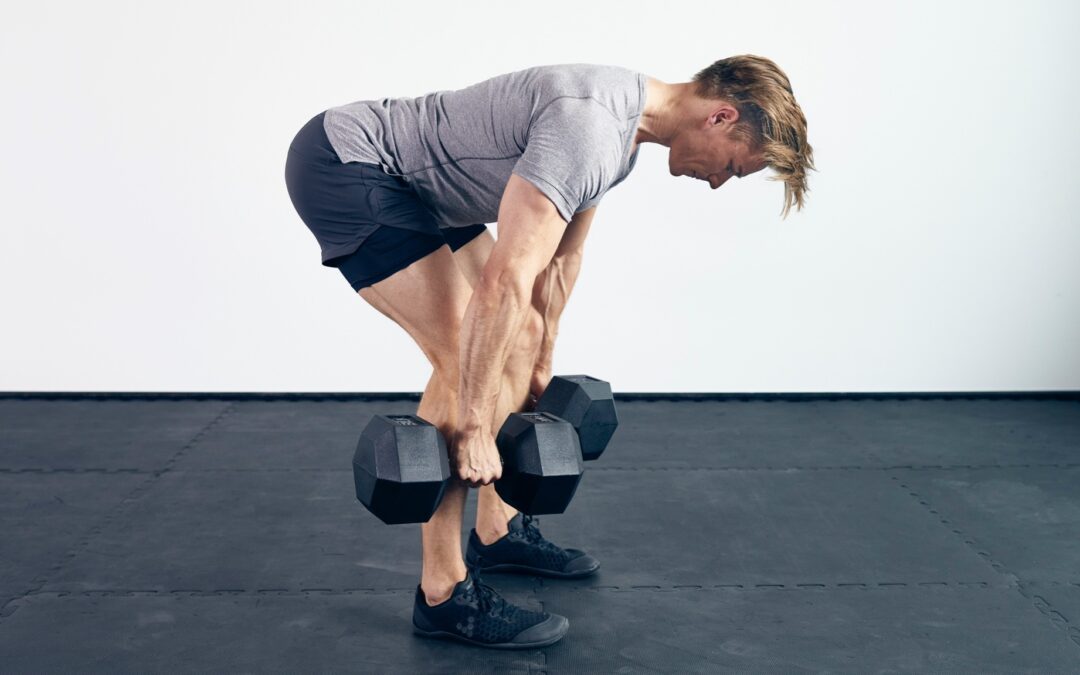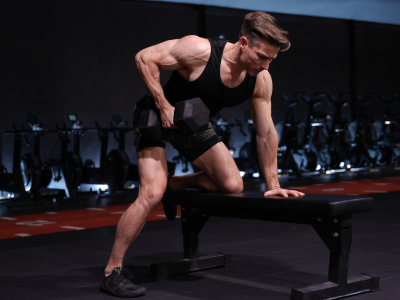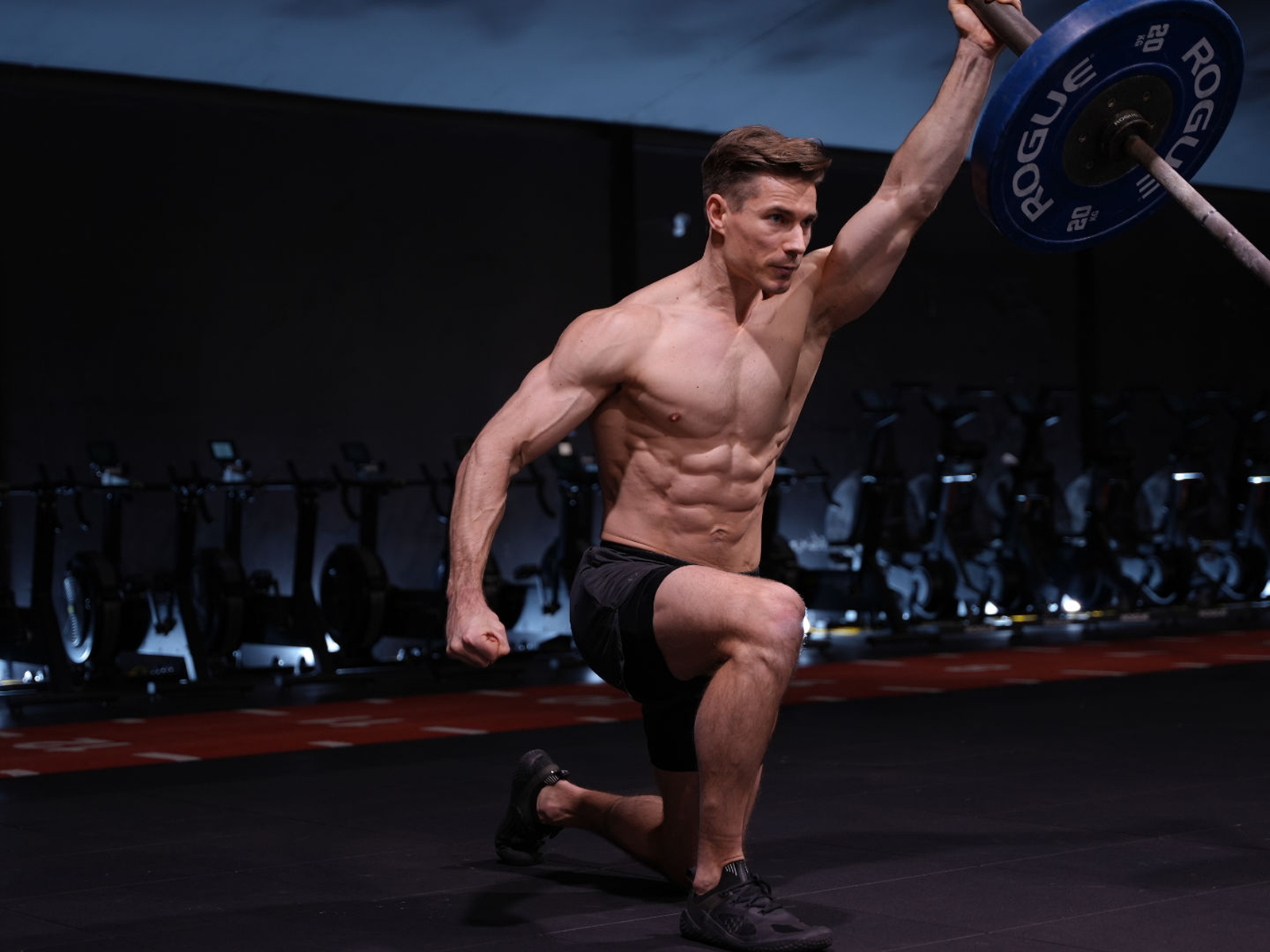Hip Hinge Exercises for Strength and Mobility
The hip hinge – the “forgotten” movement pattern that is king for building strong, mobile hips, glutes & hamstrings that pop and a resilient low back.
You do push and pull movements for the upper body, right? You should be squatting and hip hinging in equal measure for the lower body too.
So if hip hinging is so damn effective and important, then why has this movement escaped your weight training routine?
I’ll give you three possible reasons:
- When you select exercises, you’re thinking about muscles instead of movements.
- You think the only hip hinge exercise is deadlifting from the ground.
- You’re not really sure what a hip hinge is…so you stick to what you know.
Not to worry, I’m going to cover everything you need to know about hip hinging right here, right now.
Here’s a pic of me hip hinging 1.5 x bodyweight for reps, just so you feel confident I know my sh*t.

But seriously, I’ve been a strength coach for a decade now and trained much longer than that. I’ve learned from world renowned experts in the field of strength & conditioning and helped people from all walks of life develop their strength, mobility and fitness.
I’m going to arm you with more knowledge than your local trainer about hip hinging. You’ll learn what it is, how to do it and how to confidently train the movement so you can reap the rewards.
Let’s dive in!
What is a hip hinge?
As the name suggests, the hip hinge is a movement of the hips.
It occurs when the pelvis tilts forward which squares your torso to the ground. As you return to an upright position, the pelvis tilts back and your body returns to an upright posture.
A key characteristic of a hip hinge is that the spine remains in a neutral position throughout the movement, which means that the natural curvature of the spine is maintained. So a hip hinge involves pure hip motion and the spine comes along for the ride.
A helpful analogy is to think of it like tipping water out the front of a bucket.
Here’s an illustration to help visualize this.

What muscles does a hip hinge work?
When you perform a hip hinge, the muscles of the posterior chain (the backside of the body) are the key players.
Back muscles like your lats and spinal erectors work to stabilize the spine and prevent any rounding.
Hip muscles like your glutes and hamstrings control the hip hinge movement. They load and lengthen when the pelvis tilts forward, which is why you typically feel a stretch across your butt and the back of your thighs. Then, on the way up, those muscles shorten to tilt the pelvis back and return your body to an upright posture.
How to hip hinge?
It’s very important to learn how to hip hinge using just your own bodyweight before loading this movement safely. Here’s a drill to do that.
Setup.
- Stand with feet hip width apart.
- Squeeze glutes. Brace abs.
- Elbows at your sides.
- Soften the knees.
Execution.
- Push your hips back and tilt the pelvis forward (as if trying to tip water out the front of a bucket).
- To come back up, push your hips forward, squeeze the glutes and breathe out.
Why is the hip hinge important?
Lower back resilience.
The hip hinge is a fundamental human movement pattern. Every time you pick something up, your torso has to fold forward. You can accomplish this in two ways – round the spine or hinge the hips. Most people have completely lost the ability to hinge the hips and will therefore round the spine. This isn’t always bad and we shouldn’t fear rounding the spine unloaded. But it is a less resilient position and if you repeatedly move through the back, the repetitive strain can cause microtrauma that gives rise to lower back pain eventually. Hip hinging is a far better movement strategy as it evenly distributes force across the back and hip muscles. This becomes increasingly important when lifting heavier loads.
Strong, mobile hips.
The glutes get the nickname ‘powerhouse muscle’ for a reason. This big muscle, coupled with the hamstrings, are what propel you forward. They are your “go” muscles and they are best developed with hip hinge exercises.
From a mobility standpoint, you will not know what tight hamstrings feel like if you train and strengthen the hip hinge. This movement is quite literally a ‘loaded hamstring stretch’ which unlocks your hips through a combination of stretching and strengthening.
Glutes & hamstrings that pop.
Muscle grow is best achieved by loading muscles through a full range of motion. The movement pattern that does this best for the glutes & hamstrings is the hip hinge. You can squat and lunge all day, but the hip hinge is king.
To achieve muscular balance of the lower body, it’s best to include exercises across the three primary lower body movement patterns: squat, hinge and lunge.
Learn more about functional strength training on my dedicated article.
Hip hinge exercises
Hip hinge exercises exist on a continuum from low to high complexity and can be grouped into 3 categories. It’s wise to progress through the categories as you gain confidence and proficiency. But if you don’t have access to a cable machine, you can safely start with category 2. Just choose light and appropriate loads.
Category 1: Non-vertical loaded hinges.
This is a great place to start once you’re confident with your body weight hinge. Exercises in this category are the simplest to execute, they are the least demanding on the lower back and best performed light. Cable angled deadlifts and pull throughs are great options. Here’s a demo for the cable pull through.
- Cable pull through
Setup.
- Attach rope to low cable pulley, set just under groin.
- Reach between legs to grab the end of rope, step forward to create tension.
- Set feet wider than shoulders with toes turned slightly outwards.
- Keep arms straight, hands and elbows turned up.
- Knees slightly bent.
Execution.
- Reach hips back and tilt pelvis forward.
- Then, drive hips forward, tuck, and squeeze glutes.
Category 2: Vertical loaded hinges.
This category of hip hinge exercises involve axial loading. Romanian deadlifts are your go-to’s. This is just the name of a pure hip hinge with weights in your hands. There are many variations. Here’s one favourite.
- Dumbbell Romanian deadlifts
Setup.
- Start with feet hip width apart.
- Hold dumbbells at a 45 degree angle to thighs.
- Slight bend in the knees.
Execution.
- Reach hips back and tilt pelvis forward.
- Then, drive hips forward, tuck, and squeeze glutes.
Category 3: Modified hip hinges.
This category of hip hinge exercises include the many variations of deadlifts from the floor. They are classified as “modified” hip hinges because they are more of a “hingey-squat” than a pure hinge like the previous two categories.
There are different ways to deadlift, from implement to stance to modifying the starting height. Deadlifts often require some modifications to match a person’s unique body type. This is why it is considered a more advanced exercise.
- Modified Hybrid Stance Romanian deadlifts
Setup.
- Stand over the barbell.
- Feet hip width apart and the barbell directly over mid foot.
- Hinge the hips and squat down to pick grab the bar.
Execution.
- Take a deep breathe
- shift hips back until shoulders are stacked over the bar
- Push feet strongly into ground to drive the hips forward and stand up powerfully.
- Lower the bar under control. Breathe out.
- Repeat the process for desired reps.
Hip hinge summary
My hope is that you now feel a lot more confident about the esoteric ‘hip hinge’.
To summarize, the movement is basically a forward and backward tilt of your pelvis in which the spine comes along for the ride, maintaining it’s natural curvature.
The benefits include building strong, mobile hips, glute and hamstring muscle mass and a resilient low back. The exercises exist on a continuum from simple to more complex.
But the golden rule is that you should learn how to hinge your hips with just your bodyweight first before loading with various exercises.
If you’d like to learn more about this topic, I would encourage you to take my online class ‘master the hinge’. It includes thorough video tutorials to learn how to hip hinge, including form corrections and drills to master the movement. It also includes many more exercises than what is shown here. You’ll walk away very confident in your ability to train the hip hinge movement safely and which exercises are best for you.
Sign up to my Wednesday wisdom newsletter to be the first to know when this goes live (very, very soon!).
Thanks so much for reading.
Coach Jack.
Hip hinge frequently asked questions
Struggling to hip hinge.
Practice the bodyweight hinge daily. 10 reps in the morning and evening and include it in your weight training warm ups. Core stability and hip mobility must be addressed too. See here for relevant learnings.
Are squats a hip hinge?
No.
The squat and hip hinge are separate movement patterns.
The confusion lies in the fact that the squat requires a slightly forward leaning torso which means that you do need to hinge your hips slightly. A pure hip hinge on the other hand requires full excursion of the pelvis (forward and backward tilt) unless it’s a modified hip hinge exercise from the ground like a conventional deadlift, which is basically a combination of a hinge and squat.
Pain with the hip hinge.
Here are 6 quick tips.
1. Master the bodyweight hinge FIRST. Learning to move from the hips and maintain a neutral spine is of the utmost importance.
2. Learn proper breathing, bracing and core stability. This is what gives tremendous stability to your spine.
3. Never fail a rep. As soon as your lower back fatigues, you will likely round the lumbar spine. This is the mechanism of most deadlift injuries. So keep every rep clean and stay away from failure.
4. Stick to non vertical loaded hip hinge exercises. Pull throughs and cable angled deadlifts are easier to master and subject the lower back to less stress.
5. Strengthen your weak links. Core stability, lateral glutes and hamstring isolations will buttress your spine.
6. If it hurts, don’t do it. Never push through pain. Find an alternative exercise and address the root cause.



